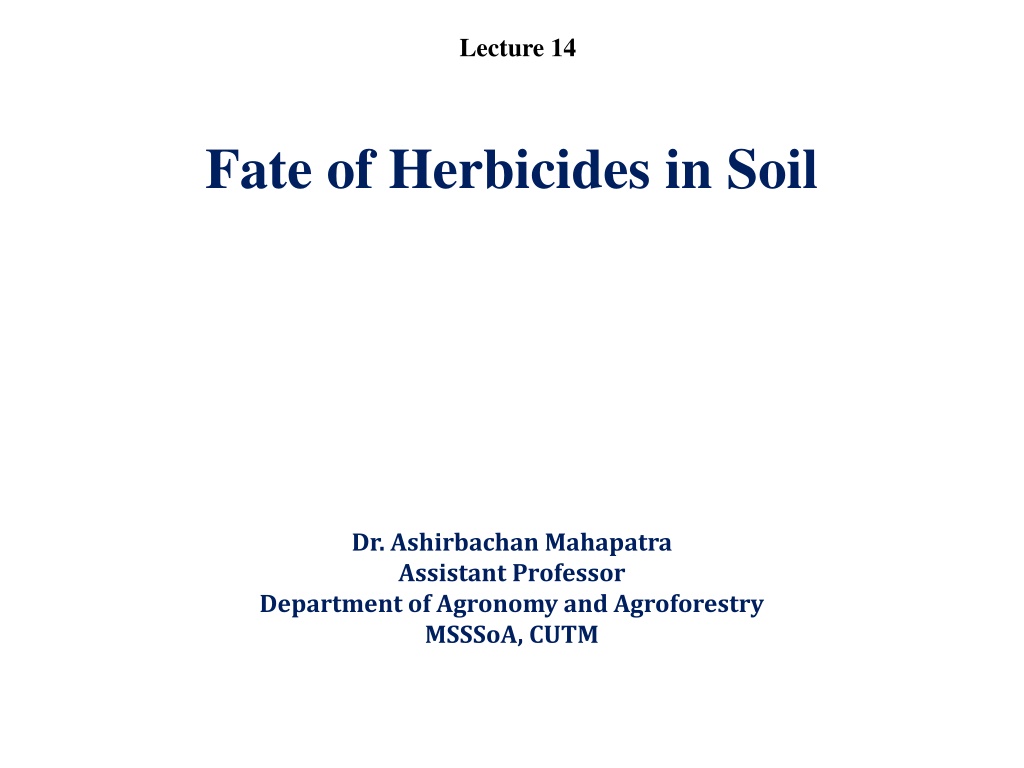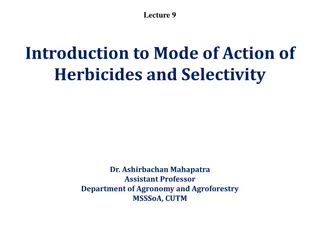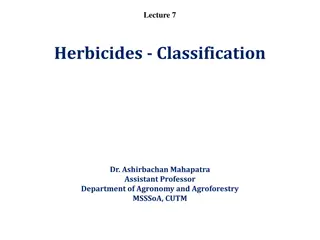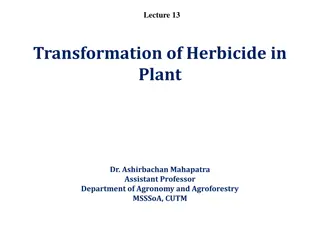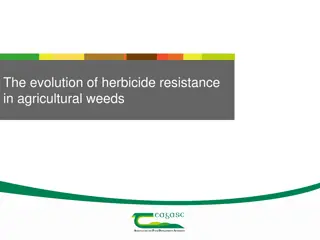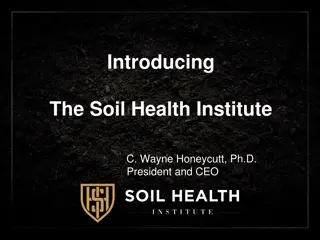Understanding the Fate of Herbicides in Soil
The fate of herbicides in soil is influenced by factors such as micro-organism decomposition, chemical decomposition, photodecomposition, adsorption by soil, surface runoff, leaching, plant uptake, and volatilization. Micro-organisms like algae, fungi, actinomyces, and bacteria play a crucial role in degrading herbicides in the soil. Chemical degradation, photodegradation, and adsorption by soil particles further affect the persistence and effectiveness of herbicides. Understanding these processes is essential for sustainable weed management and environmental protection.
Download Presentation

Please find below an Image/Link to download the presentation.
The content on the website is provided AS IS for your information and personal use only. It may not be sold, licensed, or shared on other websites without obtaining consent from the author. Download presentation by click this link. If you encounter any issues during the download, it is possible that the publisher has removed the file from their server.
E N D
Presentation Transcript
Lecture 14 Fate of Herbicides in Soil Dr. Ashirbachan Mahapatra Assistant Professor Department of Agronomy and Agroforestry MSSSoA, CUTM
Fate of Herbicides in Soil The fate of herbicides in soils pertains to their interaction with soil environment. Factors influencing persistence of herbicides are : 1. Micro-Organism Decomposition 2. Chemical Decomposition 3. Photodecomposition 4. Adsorption of Herbicide by the Soil 5. Surface Runoff 6. Leaching 7. Plant Uptake 8. Volatilization
Micro-Organism Decomposition The principal micro-organisms in the soil are algae, fungi, actinomyces, and bacteria. They must have food for energy and growth. Organic compounds of the soil provide this food supply, except for a very small group of organisms that feed on inorganic sources. Microbial degradation occurs when microorganisms such as fungi and bacteria use a herbicide as a food source. Conditions that favor microbial growth include warm temperatures, favorable pH levels, adequate soil moisture, oxygen and fertility. Adsorbed herbicides are more slowly degraded because they are less available to some microorganisms. Micro-organisms use all types of organic matter, including organic herbicides. Some chemicals are easily decomposed (easily utilized by the microorganisms), whereas others resist decomposition.
Chemical Decomposition Chemical degradation is the breakdown of a herbicide by soil processes not involving a living organism. Adsorption of the herbicides, soil pH, soil temperature and moisture influence the rate of degradation. Some herbicides are more rapidly degraded on low pH soils. Chemical decomposition destroys herbicides through interaction with the soil constituents of oxygen, hydrogen or water. Hydrolysis (interaction with water), for example, is responsible for inactivating atrazine in the soil. Photodecomposition Photodegradation is the breakdown of herbicides by the action of sunlight. Herbicides applied to foliage or the soil surface may be broken down by exposure to light. Soil incorporation can reduce herbicide exposure to sunlight. Ultraviolet light from the sun decomposes many herbicides applied to the soil surface. Some herbicides such as fluchloralin, trifluralin are recommended for soil incorporation as they break down readily when exposed to sunlight.
Adsorption of Herbicide by the Soil Herbicides tend to leave the soil solution and are adsorbed by clay and organic matter particles making the herbicide unavailable for uptake by the weed. Research has shown that: Soils high in organic matter require relatively large amounts of pre-emergence and soil sterilant herbicides for weed control. Soils high in clay content require more herbicide than sandy soils for pre-emergence or soil sterilant weed control. Soils high in organic matter and clay content tend to hold the herbicides for a longer time than sands. The adsorbed herbicide may be released so slowly that the chemical is not effective as a herbicide.
Surface Runoff Runoff moves herbicides in surface water, either mixed in the water or bound to soil particles. The amount of herbicide runoff depends on the grade or slope of the field, the type of soil, the amount of rainfall (especially close to the time of application) and properties of the herbicide. For example, a herbicide applied to a saturated clay soil is highly susceptible to runoff. Established vegetation or plant residues reduce runoff. Herbicide runoff is greatest when heavy rainfall occurs shortly after application. No-tillage, minimum-tillage and soil incorporation reduce runoff. Surface grading, drainage ditches and dikes, and the use of border vegetation can help reduce herbicide movement into surface water. Leaching Leaching is the movement of herbicides through the soil into groundwater. Several factors influence leaching, including water solubility of the herbicide, soil structure and texture, and persistence of herbicide adsorption to soil particles. If a herbicide is strongly adsorbed to soil particles, it is less likely to leach, regardless of its solubility, unless the soil particles themselves move with the water flow. Leaching occurs in any direction (downward, upward, sideways).
Plant Uptake The uptake of herbicides by plant roots results in their removal from the environment; hence, reduced concentrations in the soil. Absorption is the process by which plants and microorganisms take up chemicals. Once absorbed, most herbicides are degraded within plants. Residues may persist inside the plant or be released back into the environment as the plant decays. Volatilization Volatilization occurs when a solid or a liquid turns into a gas. A pesticide in a gaseous state can be carried away from the treated area by air currents. This is called vapor drift. Unlike the drift of sprays and dusts that can sometimes be seen during application, vapor drift is invisible. Avoid applying volatile herbicides when conditions favor volatilization, such as temperature inversions. Herbicide labels usually mention the potential for volatility of herbicides. Volatilization can sometimes be reduced through the use of low volatile formulations or soil incorporation of the herbicide.
